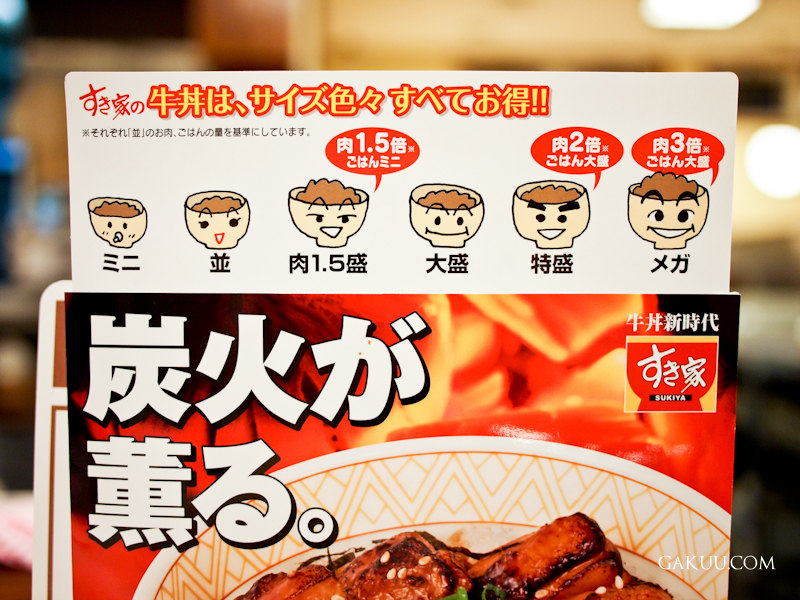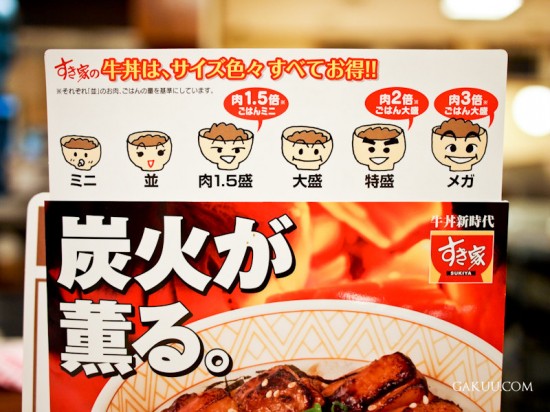Alrighty then. Here’s one sign straight from the ‘bowls’ of Sukiya, a 牛丼 (ぎゅうどん) chain here in Japan. I was tickled by the cute illustrations of the various sizes of beef bowls available!
Let’s begin from the top then!
すき家の 牛丼は、サイズ 色々 すべてお得!
(In hiragana: すきやの ぎゅうどんは、 サイズ いろいろ すべておとく!)
So すき家 (Sukiya) is the name of this restaurant chain in Japan that generally sells bowls of delicious rice with toppings of beef and other things. The most famous of which is the 牛丼 – the ‘beef bowl’. The 丼 part stands for どんぶり – the large-ish bowl used to contain all the goodies.
There are various other types of donburi too, such as 親子丼 (おやこどん) – chicken and egg donburi and 天ぷら丼 (てんぷらどん) – tempura donburi (which usually includes seafood with a deep-fried covering).
So far then:
すき家の牛丼は、
Sukiya’s gyudon are,
Following that, サイズ meaning ‘size’ and 色々 meaning ‘various types’. Nothing particularly special here except that in a grammatically correct sentence, we’d probably use で to mean ‘and’ after the word 色々. Like this:
サイズ色々で、すべてお得!
various sizes and, XX!
So, the elusive XX at the end. This is one word you really want to remember. お得 means ‘great value’ and is essentially used anywhere the speaker wants to grab the listener’s attention. If something is お得, you’ll be sure to find some sort of money-saving device or offer to make you want to buy. In this case, it’s the size-cost ratio of the gyudon! So:
Sukiya’s gyudon are great value and come in a range of sizes!

From left to right then:
ミニ Mini
並 (なみ) Regular
肉1.5盛 (にく1.5もり) 1.5x Meat
大盛 (おおもり) Large
特盛 (とくもり) Extra Large
メガ Mega
Of course, these ratings are particular to this gyudon restaurant, but a few are pretty standard everywhere. 並, 大盛 and 特盛 are seen in most places like this.
Finally then, let’s take a look at the last part in big letters:
炭火が薫る
(In hiragana: すみびがかおる)
炭火 is a charcoal fire or a wood fire used when roasting meats and other things. Here what is intended is to snag the hungry reader with a punchy piece of Japanese that conjures up wonderful smells. The second word, 薫る uses a special kanji for 香る – ‘to smell (like)’. It has a very pleasant meaning and is rarely used for smells that are bad. Hence, in this case we have が connecting charcoal and lovely smell that makes you hungry. Literally this:
The charcoal smells.
A direct translation doesn’t really do it justice though. Perhaps maybe this:
The scent of charcoal.
or maybe even:
Smoked beef/chicken
(etc. – depending on the food. In English we tend to talk about food being smoked.)
That’s all for now! Questions below :).


Leave a Reply